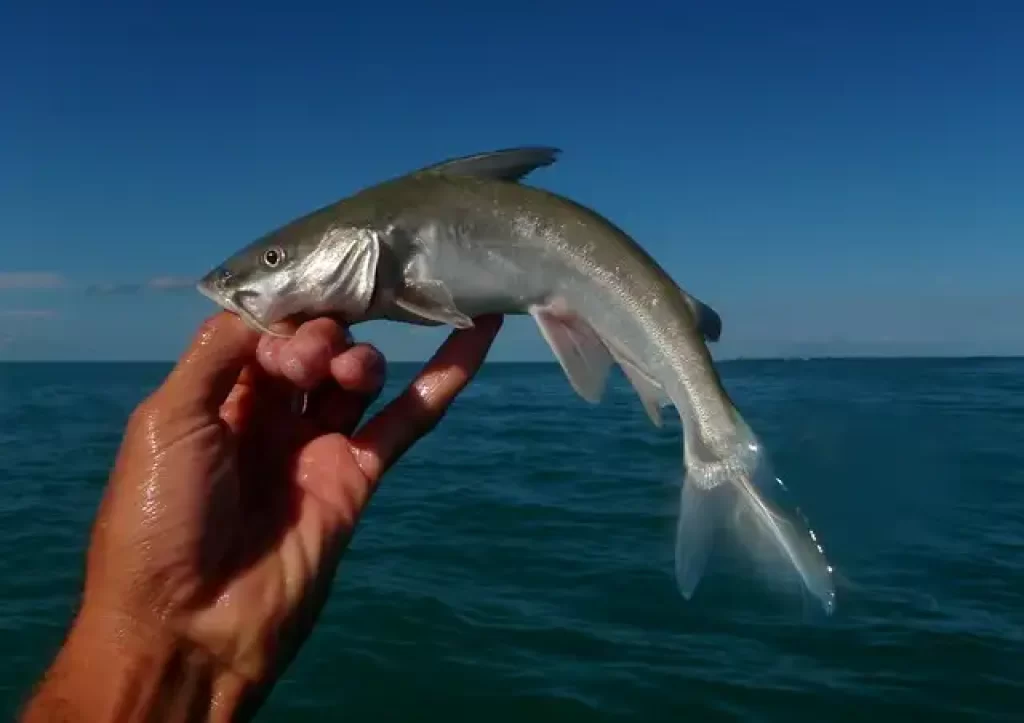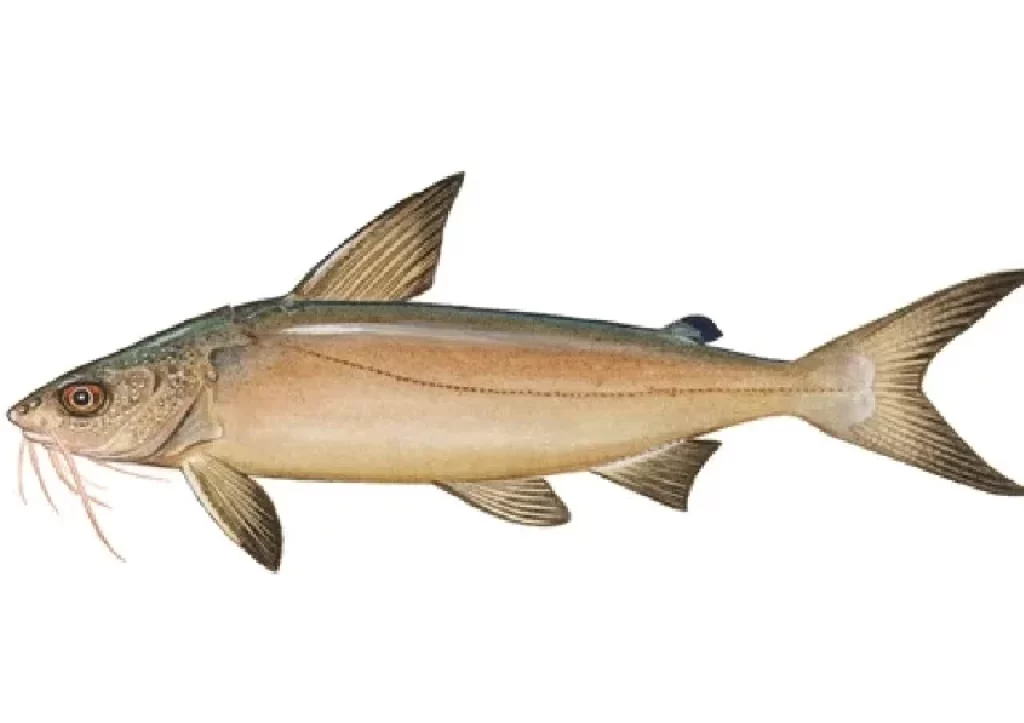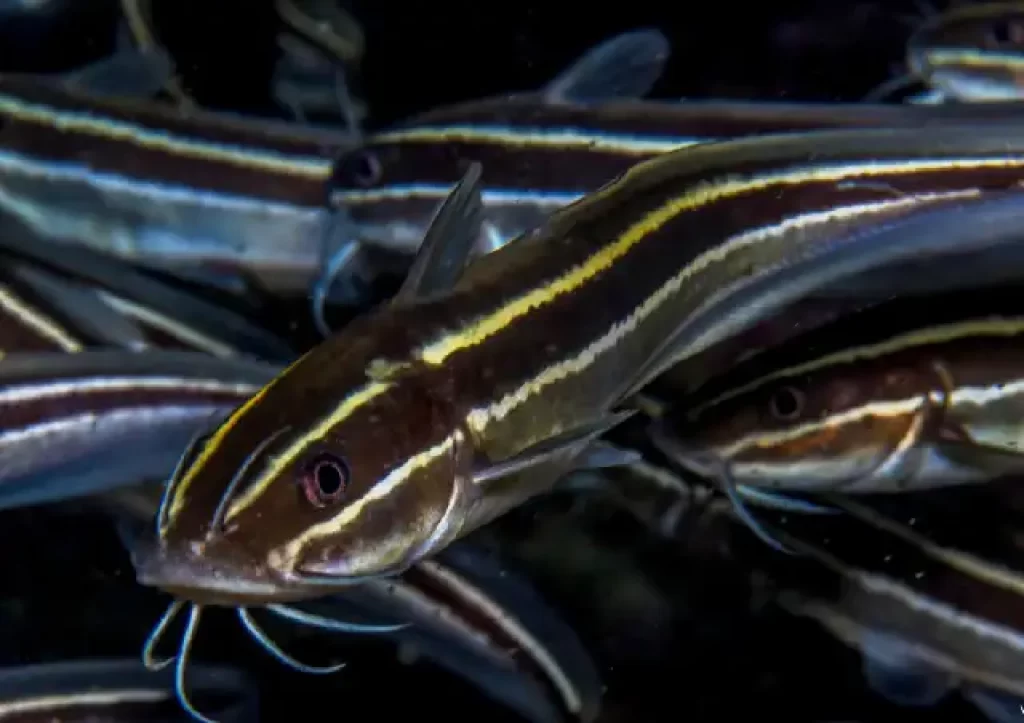Yes, you can eat saltwater catfish, and they are not poisonous. However, like any fish, it is important to properly clean and prepare them before cooking and consuming them.
Saltwater catfish, also known as hardhead catfish or saltwater bullheads, are commonly found in the coastal waters of the Gulf of Mexico and the Atlantic Ocean.
They have a reputation for being a “trash fish” due to their strong flavor and spiny fins, but they can be quite tasty when prepared correctly.
Personal preference plays a big role in determining what types of fish people choose to eat. While some people may not enjoy the taste of saltwater catfish, others may find it to be a delicious and flavorful option.
As long as the fish is properly cleaned and prepared, there is no reason why it cannot be enjoyed as part of a healthy and balanced diet.
It is worth noting that some people may have allergies to certain types of fish, including catfish. If you have never eaten saltwater catfish before, it is a good idea to start with a small amount and monitor your body’s reaction.
Is Saltwater Catfish Edible Or Poisonous?
To clarify, not all saltwater catfish are poisonous, but some species may have sharp spines on their backs that can secrete a toxin or venom. These spines are primarily used as a self-defense mechanism to protect the catfish from predators.
If you come into contact with a saltwater catfish’s spines, the venom can cause pain, swelling, and even allergic reactions. It is important to seek medical attention if you are stung by a saltwater catfish.
However, this does not mean that saltwater catfish are inedible. The actual meat of the catfish is perfectly safe to eat and is considered a delicacy in some parts of the world.
As with any seafood, it is important to properly clean and prepare the fish to ensure that it is safe for consumption.
Do Saltwater Catfish Taste Good?
The taste of saltwater catfish can vary depending on the species and how it is prepared. Some people describe the flavor as mild and sweet, with a firm texture that is similar to other whitefish. Other people find the taste to be slightly earthy or muddy, especially if the catfish is not properly cleaned.

Overall, saltwater catfish can be a delicious seafood option if prepared correctly. It is often grilled or fried, and can be served with a variety of sauces or seasonings to enhance the flavor. However, like with any seafood, the taste can be subjective and may not be to everyone’s liking.
Types Of Saltwater Catfish
There are many different species of saltwater catfish, but some of the most common types include:
Hardhead catfish (Ariopsis felis)

The Hardhead catfish (Ariopsis felis) is a saltwater catfish that is one of the most common catfish species found in the Gulf of Mexico and along the Atlantic coast of the United States.
They are often found in shallow, brackish waters such as bays, estuaries, and tidal creeks, and are known for their hard, bony heads which are covered in small spines.
Hardhead catfish are typically small, growing to an average length of 12-18 inches (30-45 cm), and are often caught for sport or for use as bait.
While they can be eaten, they are not generally considered to be a highly prized food fish due to their relatively bland flavor and tough, gristly meat. However, some people do enjoy eating them, and they can be prepared in a variety of ways including frying, grilling, or baking.
Gafftopsail catfish (Bagre marinus)
This is another common saltwater catfish found in the Gulf of Mexico and along the Atlantic coast of the United States. They have a distinctive sail-like dorsal fin.
Yellow sea catfish (Arius thalassinus)

The Yellow sea catfish (Arius thalassinus) is a saltwater catfish found in the Indo-Pacific region, including the waters around Southeast Asia and northern Australia.
They are typically found in estuaries, mangroves, and other shallow, brackish water environments, and can grow up to 60 cm in length.
They are named for their distinctive yellow coloration, which can range from pale yellow to bright gold.
While they are not commonly consumed in many parts of the world, they are considered a food fish in some parts of Asia and can be prepared in a variety of ways including grilling, steaming, or frying.
It’s worth noting that some species of catfish, including the Yellow sea catfish, can be venomous and may cause serious injury if mishandled or consumed improperly.
Striped eel catfish (Plotosus lineatus)

The Striped eel catfish (Plotosus lineatus) is a saltwater catfish that is found in the Indian and Pacific Oceans, including the waters around Southeast Asia and northern Australia.
They are typically found in shallow, brackish water environments such as estuaries, mangroves, and tidal flats.
They are named for their distinctive striped pattern, which runs vertically along their bodies. The Striped eel catfish can grow up to 30 cm in length and can be both venomous and edible, although they are not commonly consumed by humans.
Coral catfish (Plotosus japonicus)
The Coral catfish (Plotosus japonicus) is a saltwater catfish found in the Western Pacific, including the waters around Japan and Korea. They are typically found in rocky or coral reef environments and can grow up to 30 cm in length.
They are named for their vibrant coloration, which ranges from pinkish-orange to reddish-brown, and have a distinctive flattened body shape.
While they are not commonly eaten in many parts of the world, they are considered a delicacy in some parts of Asia, particularly in Japan where they are often prepared in sushi or sashimi dishes.
However, it’s worth noting that some species of catfish, including the Coral catfish, can be venomous and may cause serious injury if mishandled or consumed improperly.
Blue catfish (Arius graeffei)
This is a saltwater catfish found in the Indian and Pacific Oceans, including the waters around Southeast Asia and northern Australia.
These are just a few examples of the many different types of saltwater catfish that exist. Each species has its own unique characteristics and can be found in different parts of the world.
Can You Eat Gafftop Catfish?
Yes, Gafftopsail catfish can be eaten, and are considered a popular game fish in the Gulf of Mexico. However, they are not as highly regarded for their flavor as some other species of catfish, and are often considered to be a “trash fish” by some anglers. Despite this, they can still be cooked and prepared in a variety of ways, including baking, grilling, frying, or smoking.
Here are a few more details about eating Gafftopsail catfish:
Size
Gafftopsail catfish can grow up to 4 feet in length and weigh up to 50 pounds, although they are more commonly caught at around 1-2 feet long.
Taste
Some people describe the taste of Gafftopsail catfish as being somewhat bland or muddy, although this can depend on how the fish is prepared.
Preparation
Gafftopsail catfish can be prepared in a variety of ways, including baking, grilling, frying, or smoking. Some people recommend soaking the fish in milk or buttermilk before cooking to help reduce any potential “muddy” taste.
Regulations
It’s important to check local regulations before fishing for or consuming Gafftopsail catfish, as some areas may have restrictions on the size or number of fish that can be caught. Additionally, it’s important to be aware of any potential health risks associated with consuming fish caught in certain areas, such as exposure to toxins or pollutants.
When should you not eat catfish?
Regarding when it is safe to eat catfish, it is generally safe to eat as long as it is cooked properly. Undercooked or raw catfish can carry harmful bacteria and parasites that can cause foodborne illness. To ensure safety, it is important to cook catfish to an internal temperature of 145°F (63°C).
In terms of nutrition, catfish is a lean source of protein and is low in calories. It also contains beneficial nutrients such as omega-3 fatty acids and vitamin B12, which can support overall health. Baked or broiled catfish can be a healthy addition to a well-rounded diet.
However, it is important to be mindful of portion sizes and to avoid adding excessive amounts of high-calorie toppings or sauces.
Bellow are Certain situations when it is not recommended to eat catfish:
Spoiled fish
If catfish has been stored improperly or for too long, it can spoil and become unsafe to eat. Signs of spoiled catfish include a foul odor, slimy texture, and discoloration. If you suspect that the catfish is spoiled, it should be discarded and not consumed.
Allergic reaction
Some people may be allergic to catfish or other types of fish. If you experience symptoms such as hives, swelling, or difficulty breathing after consuming catfish, you may be allergic and should avoid eating it in the future.
Contaminated water
Catfish can accumulate toxins and other contaminants if they are caught in polluted waters. It is important to be aware of the source of the catfish and to avoid consuming fish caught in contaminated waters.
How To Clean Saltwater Catfish
Removing the head
Use a sharp knife to cut through the fish’s spine just behind the gills, and then pull the head away from the body.
When removing the head of a saltwater catfish, you’ll want to use a sharp knife to make a cut through the fish’s spine just behind the gills. Once the cut has been made, you can then grip the head firmly and pull it away from the body of the fish. It’s important to be careful when handling the fish and the knife to avoid injury.
Removing the skin
To remove the skin of a saltwater catfish, you can use a pair of pliers or a fish scaler to grip the skin near the tail and pull it away from the flesh in one smooth motion.
It’s important to be careful not to cut through the skin or flesh, as this can make the process more difficult. Repeat this process along both sides of the fish until all the skin has been removed.
Gutting the fish
To gut a saltwater catfish, you’ll want to use a sharp knife to make a shallow cut along the underside of the fish from the head to the vent (anus).
Be careful not to cut too deeply, as this can puncture the organs and make a mess. Once the cut has been made, carefully pull out the guts and discard them. It’s important to remove all of the organs, as they can spoil quickly and affect the flavor of the fish.
Removing the fillets
o remove the fillets from a saltwater catfish, you’ll want to use a sharp knife to cut along the spine from the head to the tail.
Once the cut has been made, use the knife to make a cut along the ribcage to free the fillet from the bones. Repeat this process on the other side of the fish to remove the second fillet.
Be sure to remove all of the bones and any remaining internal organs to ensure the fillet is clean and ready for cooking.
Trimming the fillets
To trim the fillets of a saltwater catfish, you can use a pair of scissors or a sharp knife to remove any remaining bones, scales, or other unwanted parts.
It’s important to be careful when trimming the fillets to avoid removing too much of the flesh or creating uneven cuts. Once the fillets have been trimmed, they are ready to be cooked according to your preferred method.
Rinsing the fillets
After trimming the fillets of a saltwater catfish, it’s important to rinse them thoroughly under cold running water.
This helps to remove any remaining blood or debris from the fish and ensures that the fillets are clean and ready to be cooked. Once the fillets have been rinsed, they can be patted dry with a paper towel before cooking.
Once the fillets have been cleaned, they can be cooked using a variety of methods including frying, baking, grilling, or poaching.
It’s important to note that some species of saltwater catfish can be venomous, so it’s important to take care when handling and cleaning them to avoid injury.
How to Cook Saltwater Catfish
Saltwater catfish can be cooked in a variety of ways, including baking, frying, grilling, and broiling. Here are some common methods for cooking saltwater catfish:
Baked Catfish
Preheat the oven to 400°F (200°C). Season the catfish fillets with salt, pepper, and any other desired spices. Place the fillets in a baking dish and drizzle with olive oil. Bake for 15-20 minutes, or until the fillets are cooked through and flaky.
Fried Catfish
Heat a skillet or deep fryer with oil to 375°F (190°C). Mix together cornmeal, flour, salt, and pepper in a shallow dish. Dredge the catfish fillets in the mixture until coated. Fry the fillets in the hot oil until golden brown and crispy, about 3-5 minutes per side.
Grilled Catfish
Preheat the grill to medium-high heat. Season the catfish fillets with salt, pepper, and any other desired spices. Grill the fillets for 3-4 minutes per side, or until the fish is cooked through and has grill marks.
Broiled Catfish
Preheat the broiler and place the catfish fillets on a broiler pan. Season with salt, pepper, and any other desired spices. Broil the fillets for 5-6 minutes per side, or until the fish is cooked through and lightly browned.
No matter which cooking method you choose, it’s important to ensure that the catfish is cooked to an internal temperature of 145°F (63°C) to ensure that it is safe to eat. Enjoy your delicious saltwater catfish!



